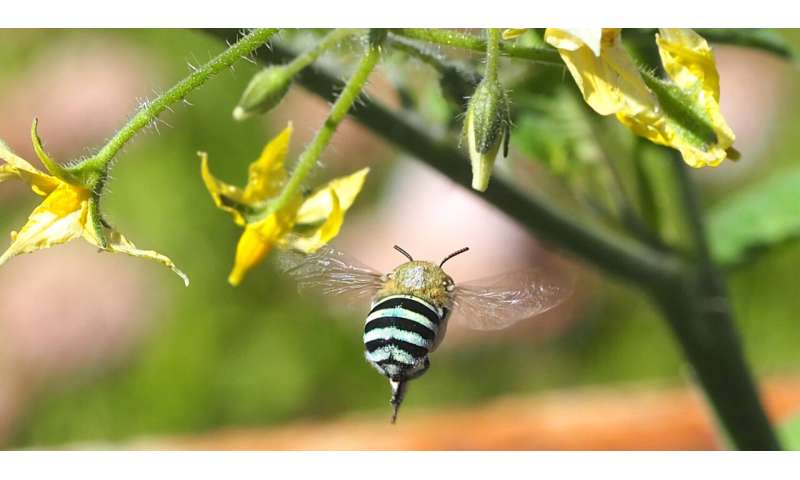Researchers must ‘bee’ sweep netting to learn more about native bees

Novel research into native bee populations by Curtin University provides a best practice recommendation on how to accurately monitor these important insects, with the aim of monitoring and saving bee species from emerging environmental threats.
Curtin Ph.D. candidate and Forrest Foundation Scholar Miss Kit Prendergast, from the School of Molecular and Life Sciences, said while there are currently numerous surveying and sampling methods for bees, there is no consensus within the scientific community on which are the best in practice.
“In order to learn more about the bees, it is important to be able to catch and monitor them in the most effective and efficient manner. Our research explored this and concluded sweep netting was the best method for collecting the greatest number and diversity of bees,” Miss Prendergast said.
“Native bees are vital components of ecosystems—they are intrinsically valuable through contributing to the biodiversity of life, and they are important pollinators of flowering plants. Consequently, their loss can lead to declines in flowering plants, with cascading effects throughout the ecosystem.
“My research involves saving the bees by identifying what factors can boost native bee numbers, as well as what factors threaten their survival. But to make any solid conclusions, I first needed to determine how to effectively survey native bee populations.
“WA hosts around 800 species of bees, yet no systematic surveys of native bees in the urbanised areas of this region, such as the Perth area, have previously been published. This was a major knowledge gap, given that Perth is a rapidly urbanising region, yet is located in an internationally recognised biodiversity hotspot.”
To carry out the research, Miss Prendergast compared methods currently used when monitoring bee populations: actively counting bees by observation; actively catching them with an entomological net; and passively collecting bees, using blue and yellow bowls and vane traps.
“I found that passive methods—setting out bee bowls and vane traps—were the least effective for monitoring bees, with only a small fraction of species and individuals being collected, giving a very biased estimate of the true diversity present,” Miss Prendergast said.
“The only exception was for the Amegilla—large, important buzz-pollinating bees—which were caught in very high abundances in blue, but not yellow, vane traps.”
While the observation method—simply watching flowers and recording how many bees were observed—proved to be quite successful in determining overall bee numbers, Miss Prendergast explained it was nearly impossible to identify the different species of native bees by observation alone.
“Native bees on average are about one centimetre long, with numerous species being only about 4 millimetres long. This means the differentiating details, like sculpturing of the body and shape of the wing veins of each species are microscopic—it’s not something you can readily see with the naked eye,” Miss Prendergast said.
“Therefore in order to know exactly what species of bees are present in the area, scientists must be able to catch the bees and have a closer look.”
When it came to catching methods, sweep netting was the most successful, and many bee species in the study were caught exclusively this way.
“Sweep netting is no easy task—you need good eyesight and good reflexes to catch these tiny bees,” Miss Prendergast said.
“Overall, our research concludes that a variety of methods combined is the best suggested practice to accurately monitor native bee populations, as each method did have its own biases. However if scientists are to select one specific collection method to monitor bee populations, sweep netting is indispensable.”
The full paper, “The relative performance of sampling methods for native bees: an empirical test and review of the literature,” is published in Ecosphere.